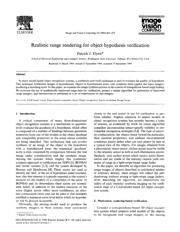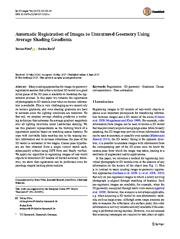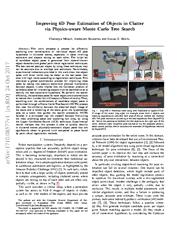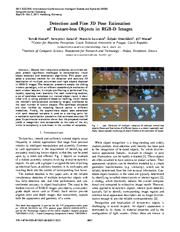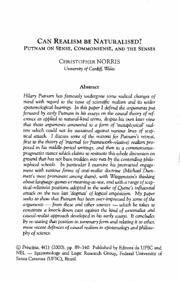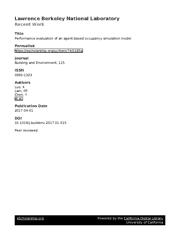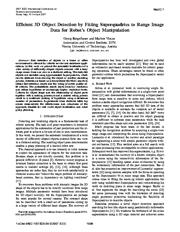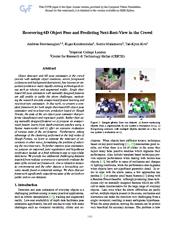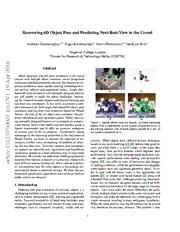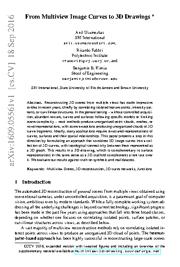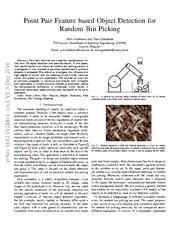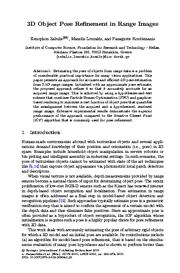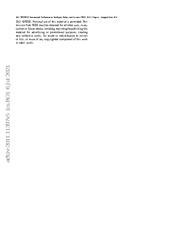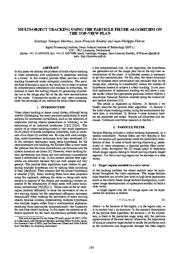A copy of this work was available on the public web and has been preserved in the Wayback Machine. The capture dates from 2006; you can also visit the original URL.
The file type is application/pdf.
Filters
Realistic range rendering for object hypothesis verification
1996
Image and Vision Computing
We motivate the use of synthetically shadowed range data for verification, present a simple algorithm for generation of shadowed range imagery, and demonstrate its usefulness in a set of experiments on ...
In many model-based object recognition systems, a synthesize-and-verify technique is used to evaluate the quality of hypotheses. ...
Verification with 'realistic' range data Our primary motivation for incorporating shadowing into synthetic range image generation is twofold. ...
doi:10.1016/0262-8856(95)01063-7
fatcat:xf3z6vg64ndtnhhiz2egf6irii
Model-based 3D object recognition by a hybrid hypothesis generation and verification approach
1994
Intelligent Robots and Computer Vision XIII: Algorithms and Computer Vision
We present a model-based 3D object recognition architecture that combines pose estimation derived from range images and hypothesis verification derived from intensity images. ...
The architecture takes advantage of the geometrical nature of range images for generating a number of hypothetical poses of objects. ...
ACKNOWLEDGEMENTS The presented work is sponsored by the Swiss National Fund for Scientific Research under project number 5003-34336 and is a collaboration with Charles Baur and Emerico Natonek of the Swiss ...
doi:10.1117/12.188936
fatcat:ncxd5srkfzb2rhdoiproj6kz2q
Automatic Registration of Images to Untextured Geometry Using Average Shading Gradients
2017
International Journal of Computer Vision
We apply our algorithm to registering images of real-world objects to untextured 3D meshes of limited accuracy. ...
Moreover, we show that registration can be performed even for paintings despite lacking photo-realism. ...
Acknowledgements We want to thank Gianpaolo Palma as well as Michael Goesele's research group for giving access to their datasets. ...
doi:10.1007/s11263-017-1022-x
fatcat:ue4gydqnsfcarmiiutgyo6vcgu
Improving 6D Pose Estimation of Objects in Clutter via Physics-aware Monte Carlo Tree Search
[article]
2017
arXiv
pre-print
It also implies that the Cartesian product of candidate poses for interacting objects must be searched so as to identify the best scene-level hypothesis. ...
a rendering of the scene given the hypothesized pose as a score that guides the search procedure. ...
These issues were the primary motivation behind hypothesis verification (HV) methods [7] , [8] . ...
arXiv:1710.08577v1
fatcat:2vdtpoabobhpxbo7o47fxxv4fa
Detection and fine 3D pose estimation of texture-less objects in RGB-D images
2015
2015 IEEE/RSJ International Conference on Intelligent Robots and Systems (IROS)
This paper proposes a practical method for the detection and accurate 3D localization of multiple texture-less and rigid objects depicted in RGB-D images. ...
Finally, the approximate object pose associated with each detected template is used as a starting point for a stochastic optimization procedure that estimates accurate 3D pose. ...
Hypothesis Verification The verification stage corresponds to the traditional template matching. ...
doi:10.1109/iros.2015.7354005
dblp:conf/iros/HodanZLOM15
fatcat:i6625bdpm5abxdr42n7ymlubru
Can Realism Be Naturalized?
2000
Principia: An International Journal of Epistemology
, and with a range of skeptical - relativist positions adopted in the wake of Quine's influential attack on the two last 'dogmas' of logical empiricism. ...
I discuss some of the reasons for Putnam's retreat, first to the theory of 'internal (or framework-relative) realism proposed in his middle-period writings, and then to a commonsense pragmatist stance ...
This reading is quite acceptable from a realist viewpoint and indeed captures one salient aspect of the case for objective (verification-transcendent) truth as opposed to the kinds of anti-realist argument ...
doaj:5b7bc53a1c374ec28e2b6645b575cc15
fatcat:yhte2t7m6vg27kedeurjts2ea4
Performance evaluation of an agent-based occupancy simulation model
2017
Building and Environment
Results demonstrated the feasibility of applying the Occupancy Simulator to simulate a range of occupancy presence and movement behaviors for regular types of occupants in office buildings, and to generate ...
stochastic occupant schedules at the room and individual occupant levels for building performance simulation. ...
Each object is modeled mathematically with its properties and behaviors. For example, the movement behavior object is modeled as an aggregation of occupancy-related events. ...
doi:10.1016/j.buildenv.2017.01.015
fatcat:2iotorbwzvezjbe3gdej2uj6mi
Efficient 3D Object Detection by Fitting Superquadrics to Range Image Data for Robot's Object Manipulation
2007
Engineering of Complex Computer Systems (ICECCS), Proceedings of the IEEE International Conference on
Criteria for object shape and the relationship of object parts together with a ranking procedure and a ranked voting process result in a combined ranking of hypothesis using a minimum number of parameters ...
In this work we present the automatic localization of a wide variety of differently shaped objects scanned with a laser range sensor from one view in a cluttered setting. ...
is sensitive to noise and outliers, which renders a stable object recognition difficult. ...
doi:10.1109/robot.2007.363129
dblp:conf/icra/BiegelbauerV07
fatcat:jsw6eeflnng6lbko3gd2q7llmm
Recovering 6D Object Pose and Predicting Next-Best-View in the Crowd
2016
2016 IEEE Conference on Computer Vision and Pattern Recognition (CVPR)
In this work, we present a complete framework for both single shot-based 6D object pose estimation and next-best-view prediction based on Hough Forests, the state of the art object pose estimator that ...
We provide two additional challenging datasets inspired from realistic scenarios to extensively evaluate the state of the art and our framework. ...
For each hypothesis we render the 3D model of the object in the scene, we exclude the parts that are occluded and define p as a point of the object model and q its nearest neighbor in the scene. ...
doi:10.1109/cvpr.2016.390
dblp:conf/cvpr/DoumanoglouKMK16
fatcat:z53gwwkmpza4hbexkkbouj6oay
Recovering 6D Object Pose and Predicting Next-Best-View in the Crowd
[article]
2016
arXiv
pre-print
In this work, we present a complete framework for both single shot-based 6D object pose estimation and next-best-view prediction based on Hough Forests, the state of the art object pose estimator that ...
We provide two additional challenging datasets inspired from realistic scenarios to extensively evaluate the state of the art and our framework. ...
For each hypothesis we render the 3D model of the object in the scene, we exclude the parts that are occluded and define p as a point of the object model and q its nearest neighbor in the scene. ...
arXiv:1512.07506v2
fatcat:hfmzicokxjhs5fjwjgbvjvb5um
From Multiview Image Curves to 3D Drawings
[chapter]
2016
Lecture Notes in Computer Science
Here, the realistically-rendered images for this scene, Figure 14 , as well as the precisely calibrated views, are obtained using Blender. ...
When such a 3D curve is projected in its entirety to a number of image views, we only expect the correct portion to gather sustained image evidence, which argues for a hypothesis verification method that ...
doi:10.1007/978-3-319-46493-0_5
fatcat:672que2qgfbo7cwxgyp7iaotqy
Point Pair Feature Based Object Detection for Random Bin Picking
2016
2016 13th Conference on Computer and Robot Vision (CRV)
Point pair features are a popular representation for free form 3D object detection and pose estimation. In this paper, their performance in an industrial random bin picking context is investigated. ...
Special thanks to Wiebe Van Ranst for helping track down some hard to find bugs. ...
[32] : they introduce a segmentation method, add a hypothesis verification stage and weigh the voting based on visibility.
C. ...
doi:10.1109/crv.2016.59
dblp:conf/crv/AbbeloosG16
fatcat:n27vzyv6nvbs5eorygzadk4fee
3D Object Pose Refinement in Range Images
[chapter]
2015
Lecture Notes in Computer Science
Estimating the pose of objects from range data is a problem of considerable practical importance for many vision applications. ...
between the acquired and a hypothesized, rendered range image. ...
Conclusions This paper has presented an approach for accurately localizing 3D objects in range images. ...
doi:10.1007/978-3-319-20904-3_25
fatcat:psjqw6x5evg3lk6iop2n2kmanu
Imagination-enabled Robot Perception
[article]
2021
arXiv
pre-print
The physics simulation ensures that object detections that are physically not possible are rejected and scenes can be rendered to generate expectations at the image level. ...
Typically the perception results do not include information about the part structure of objects, articulation mechanisms and other attributes needed for adapting manipulation behavior. ...
The corresponding virtual object for an object hypothesis o RW is denoted as o AW . Because ICBS are a three-dimensional AW, the perception system must provide 6D poses for objects. ...
arXiv:2011.11397v5
fatcat:afeiel5uinh5nijl2frxnekxmi
Multi-Object Tracking Using The Particle Filter Algorithm On The Top-View Plan
2004
Zenodo
objects because systems implementing multiple hypotheses and multiple targets suffer from a combinatorial explosion, rendering those approaches computationally very expensive for real-time object tracking ...
In this way for each visual tracker we can perform a realistic partitioning (bounding boxes) with consequent reduction in the computational cost. ...
doi:10.5281/zenodo.38521
fatcat:ntap5oqzgncyfm6rv5ibrt53ui
« Previous
Showing results 1 — 15 out of 12,944 results

